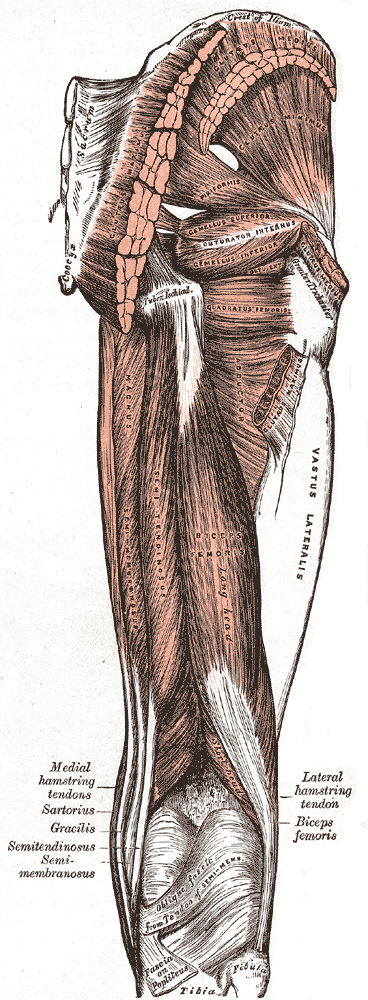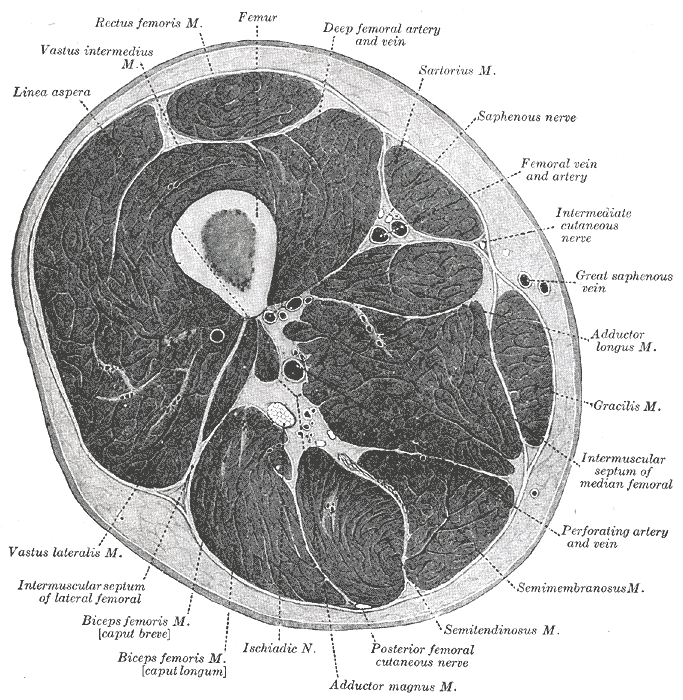Hamstring Muscles
Muscles
| Muscle | Origin | Insertion | Innervation | Action |
|---|---|---|---|---|
| Biceps femoris long head | Ischial tuberosity Sacrotuberous lig. (Common head with semitendinosus) |
Fibular head | Tibial n. L5 - S2 |
Hip: Extension Knee: Flexion, ER Pelvis: Sagittal stabilization |
| Biceps femoris short head | Lateral lip of Linea aspera | Fibular head | Common Fibular n. L5 - S2 |
Knee: Flexion, ER |
| Semimembranosus | Ischial tuberosity | Medial tibial condyle Oblique popliteal lig. Popliteus fascia |
Tibial n. L5 - S2 |
Hip: Extension Knee: Flexion, IR Pelvis: Sagittal stabilization |
| Semitendinosus | Ischial tuberosity Sacrotuberous lig. (common head with biceps femoris long head) |
Pes anserine | Tibial n. L5 - S2 |
Hip: Extension Knee: Flexion, IR Pelvis: Sagittal stabilization |
Overview
“The three biarticular hamstring muscles have their proximal attachment on the posterior side of the ischial tuberosity and attach distally to the tibia and fibula. Based on these attachments, he hamstrings extend the hip and flex the knee. The anatomy and function of the posterior head of the adductor magnus, an often underappreciated hip extensor muscle, is described under the section on adductors of the hip.”3
“Fig. 12.25 depicts the lines of force of the primary hip exten sors. In the extended position the posterior head of the adductor magnus has the greatest moment arm for extension. The adductor magnus and the gluteus maximus have the greatest crosssectional areas of all the extensors.”3
“The hamstring muscles (i.e., semimembranosus, semitendinosus, and long head of the biceps femoris) have their proximal attachment on the ischial tuberosity. The short head of the biceps has its proximal attachment on the lateral lip of the linea aspera of the femur. Distally, the hamstrings cross the knee joint and attach to the tibia and fibula”3
“All hamstring muscles, except the short head of the biceps femoris, cross the hip and knee. As described in Chapter 12, the three biarticular hamstrings are very effective hip extensors, especially in the control of the position of the pelvis and trunk over the femur.”3
“As a group, the hamstrings primarily function to extend the hip and to flex the knee. The hamstrings are innervated by branches of the sciatic nerve.”4
Action
Since the hamstrings, except for biceps femoris short head, are 2-joint muscles perform hip extension and knee flexion, their action is dependent on hip position5.
At 40° hip flexion, the hamstrings lengthen, and generally resist this lengthening by simultaneously flexing the knee5. At >90° the relative hamstring lengthening will limit knee extension5.
Increasing hip flexion lengthens the hamstrings and improves their efficiency as knee flexors5. Conversely, increasing knee extension also lengthens the hamstrings and improves their efficiency as hip extensors5.
Function
According to the Gray Institute6, the hamstrings function primarily in an upright and closed chain position6. In addition, the hamstrings are considered “knee flexors” but this lacks nuance. The Gray Institute proposes that the hamstrings control knee flexion but do not primarily cause knee flexion6. In normal function, the hamstrings react to the ground reaction forces to control knee flexion.
This is a summary of the teachings of the gray institute, but a literature review is needed to determine if the hamstrings are more reactive controllers of knee flexion
Exercise
A reverse lunge with the arms driving into trunk flexion is a way to functionally target the hamstrings, since it starts from an upright position, is in the closed kinetic chain, and requires controlled knee flexion and hip extension since the arms drive the center of mass anterior and inferior resulting in a hip flexion and knee extension torque. This movement is purely in the sagittal plane and equally targets all of the hamstrings.
To make this movement load the sagittal and frontal plane, we can swing both arms to the lateral or medial side of our lead (ipsilateral) leg. Swinging both arms down and to the outside (lateral) side of our lead leg, results in the COM moving towards laterally on the ipsilateral side, and thus recruits more of the medial hamstring group to apply an hip adduction force. When both arms swing medially to the lead (ipsilateral) leg, the COM is moving anterior, inferior, and towards the contralateral side.
To make this reverse lunge triplanar, we can add rotation to load the transverse plane. The medial hamstring group provide a tibiofemoral internal rotation moment, whereas the lateral hamstring group create a tibiofemoral external moment. Rotating the body towards the ipsilateral side, results in relative internal rotation of the tibia. Rotating the body towards the contralateral side results in relative external rotation of the tibia. By performing a reverse lunge with both arms swinging lateral to the lead leg and rotating the trunk ipsilaterally, this requires controlled deceleration of hip flexion, knee extension,
Knee Rotation
Shortness
Hamstring shortness is the result of hamstring overuse often due to taking on a compensatory role when the deep hip stabilizers are dysfunctional7.
Injury
| Grade | Description |
|---|---|
| 1 | A mild muscle injury with majority of fibers intact8 |
| 2 | Partial muscle fibers disruption8 |
| 3 | Complete muscle tear or tendon avulsion8 |
A significant aspect of hamstring rehabiltiation should be prevention due to high incidence of reinjury8.
In addition, we should be premeditatively avoiding secondary pathologies that can stem from hamstring injuries. For example, the APTA recommends proactively performing an active slump test to note sciatic nerve neurodynamic mobility8.
Risk factors for hamstring injury:
- Prior hamstring muscle injury (2x risk)8
- Increased age8
- Previous significant knee injury or surgery8
- Strength deficits of hip and pelvic musculature8
- Decreased muscle length8
- Overall limb stiffness8
- Poor lumbopelvic stability8
- Sacroiliac dysfunction8
- Proprioceptive deficits8
- Quadricep muscle length8
Examination
- Length Test
- SLR
- 90-90 knee extension
- Strength Testing
Strength Testing
The hamstrings should be measured using varying knee flexion and TFJ rotation.
The APTA recommends performing isometric strength testing at 90° (shortened) and 15° (lengthened) positions8.
The medial and lateral hamstring muscles can be biased by using internal rotation and external rotation of the tibia8. The medially located semitendinosus and semimembranosus hamstrings perform Tibiofemoral internal rotation.
Mobility Exercises
- Elephant walks
- SL HF activation + spine flexion
Use nerve bias to differentiate between sciatic nerve tension and hamstring tightness
Strength Exercises
- Nordic curl
- Cons: difficult to cue properly
- Make sure there is no hip hinge
- Long bridge
- isometric
- Bridge hamstring slideouts
- Dynamic
- KB swings
Length based exercises
- Exercises biasing fully lengthened position
- Nordic Curl
- Exercises biasing fully shortened
- Standing HS curls
- Exercises for mid range


